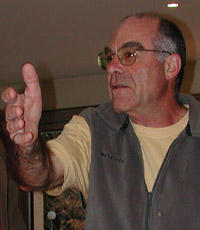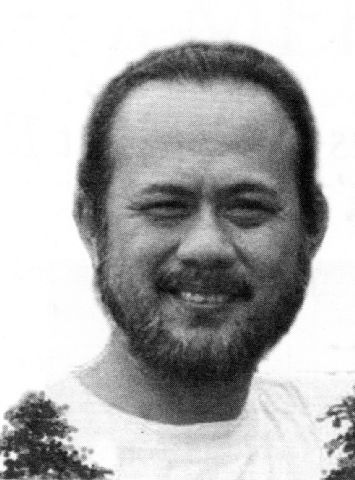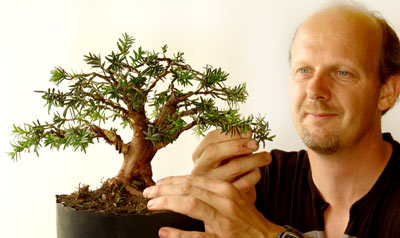| 21 |
|
| 22 | 1984 -- Interest in bonsai received a shot in the arm today with the U.S. release of the Columbia Pictures film The Karate Kid. When we first see "Mr. Kesuke Miyagi" (Noriyuki 'Pat' Morita), he is in his workshed surrounded by perhaps half a dozen small to medium potted trees. Later when "Daniel LaRusso" (Ralph Macchio) visits him again and expresses some interest in bonsai, Mr. Miyagi encourages the reluctant Daniel-san to trim a juniper. Miyagi: "Close eye[s]. Trust. Concentrate. Think only tree. Make a perfect picture down to last pine [sic] needle. Wipe mind clean [of] everything but tree. Nothing in this whole world -- only tree. You got it? Open eye[s]. Remember picture? Make like picture. Just trust picture." Daniel: "But how will I know if my picture's the right one?" Miyagi: "If come from inside you, always right one." [The movie would cause children for the next decade to gleefully shout out "Look, Karate Kid" whenever they happened upon bonsai stands or displays.] (http://us.imdb.com/ReleaseDates?0087538) |
| 23 |
1902 -- Kyuzo Murata was born in Takayama City, Gifu
Prefecture. [He would go on to influence, protect, and promote the art of bonsai in many ways.]
1973 -- The first annual Great Lakes Regional Bonsai Show began its two-day run in Cleveland, Ohio. The bonsai exhibit featured both "Judged" and "Exhibition Only" Divisions. The Feature exhibit were three saikei created by Toshio Kawamoto at Bonsai Congress '72 in Kansas City. All three of these superb saikei were won by bonsai growers in the area and all three graciously agreed to exhibit here. Demonstration rooms and commercial booths also emphasized regional experience in the show co-sponsored by the Garden Center of Greater Cleveland and the Cleveland Bonsai Club, with cooperation from Youngstown and other Bonsai Clubs of the area. (Tooker, Larry and Leo Collins "Great Lakes Regional Bonsai Show," Bonsai Magazine, BCI, Vol. XII, No. 1, Jan./Feb. 1973, pg. 9) 2006 -- Philippe Mauviet died. (Former president of the Bonsai Club of Montpellier, Philippe was then president of Féderation Française de Bonsai (FFB) from 2001 to 2002, already serving as their contact to the European Bonsai Association. He was the organizer of the EBA Convention in Trévarez in May 2002. With Momoyo Nishiyama he translated the Japanese work into French as Les genévriers (Juniperus rigida), Comment former les bonsaïs. He was also translator of the works of the German author Willi Benz. And he collaborated with Michel Sacal from 2001 to 2002 on the bimonthly periodical France Bonsai. Philippe left behind his wife, Irmi, and daughters.) 
|
| 24 |
|
| 25 |
1958 -- Robert Steven was born in North Sumatra. [He would start doing and
collecting bonsai in 1979, initially only working according to his own imagination and taste. At that
time he would not yet have joined any Bonsai club. It was not until about 1990 that he would start to
learn more about Bonsai from books and local artists. With this new exposure, the more he learned, the
more doubts he would have about the criteria that most considered necessary for making good Bonsai. The
textbook rules and stylistic considerations would seem to him to be overly dogmatic and rigid. He would
become disheartened as he would note a distinct difference between the art that he loved and the art as followed
by the rest of the community. The two ideals would be contradictory, in his estimation, and he would
almost give up on bonsai. [He would begin searching for the roots of the philosophical and conceptual fundamentals of the art. He would delve deeply into the scientific and aesthetic ideals of artistry and Bonsai to try and discover the basis for these dogmatic rules. Robert would chance upon a wonderful opportunity to learn Penjing with Hu Yun Hua in China, and that study would provide him with significant enlightenment. He would firmly believe that Bonsai was simply another form of visual art. With his frequent travels to China and his meeting with many Chinese Bonsai masters would come exposure to Chinese literature. Most of these texts would have never been translated into foreign languages. Due to his exposure to these Chinese artists and writings, Robert's perception and interpretation of Bonsai would change. The funny thing is that the Bonsai he would then be creating were not too different from what he would have created in the past. The most significant difference would be that, before, he worked intuitively without knowing why he did what he did. Now, however, he could can refine his efforts with a clear understanding of the aesthetic and a contextual approach to the work. [Beginning in 2002, he would be a BCI Board of Directors member. His first book Vision of My Soul would be published in 2005, and his second, Mission of Transformation, would come out two years later. By 2007, he would have a permanent exhibit centre with a collection of over 500 specimens in a wide variety of species, and Robert would have won more than 200 competition awards nationally as well as internationally. In mid-August of that year he would be expert editor of Green Hobby, the first bonsai magazine in the Indonesian language. He would intensively travel around the world conducting Bonsai and Penjing teaching, lectures, demos, workshops and judging including on a national TV program. In 2014 he would adopt and develop the Black Scissors concept of Chinese artist Su Fang. That idea would begin to be initiated internationally the following the following year. In 2020 he would be a guest on the 3rd episode of the new Bonsai in Conversation podcast.] 
Robert Steven
("Robert Steven," Bonsai Societies of Florida,
http://www.bonsai-bsf.com/resources/artists/artist.php?uid=13;
"Robert Steven," http://www.bonsaiempire.com/locations/bonsai-artists/robert-steven)
SEE ALSO: Aug 28, Nov 22, Dec 7
(Bonsai Magazine, BCI, Oct/Nov/Dec 2004, pg. 8) |
| 26 |
|
| 27 |
|
| 28 | 1994 -- Hugo Storer, known as the first person of bonsai in Puerto Rico, passed away at the age of 86 years. (He had visited the Brooklyn Botanical Garden sometime between 1944 and 1948. Seeing bonsai there for the first time, he acquired books and information for his return to P.R. There he started several types of tropical plants from seed. In July 1970 he founded and was first president of the Horticultural Society of P.R. to study native and imported exotic plants and organize activities on this behalf. In 1977, to promote bonsai to all corners of the island, he organized a group which would later be called Club Bonsai de P.R.) ("History of Bonsai in Puerto Rico," http://web.archive.org/web/20040615180823/http://pedrojmorales.com/bonsaipr.htm) SEE ALSO: Mar 8 |
| 29 |
1963 -- Morten Albek was born in Denmark. [He would win the Danish New Talent
Bonsai Competition in 2001 and the Keyaki Masters Talent Competition in Denmark in 2003. A member of the
All Japan Shohin-Bonsai Association
(since 2005), the British Shohin Association (since 2006) and the Danish Bonsai Society (since 1993, and since
2009 be its Chairman), Morten would also be selected as the European representative to the American Shohin Bonsai
Society in 2005. In 2003, he would establish the successful
Shohin-bonsai Europe website to promote Shohin and
Mame-bonsai more to the Western world. Morten would perform various bonsai demonstrations and
workshops, both nationally in his native Denmark, and internationally. He would write articles which would
be published in Bonsai Europe; for the all Japan Mame-Bonsai Association website; the Danish Bonsai Society
and other publications. In 2008 his book Shohin Bonsai: Unlocking the Secrets of Small Trees would
be released by Stone Lantern Publications. His non-bonsai full-time job would be as a camera operator at
a regional TV-station in Denmark. Using this skill, he would travel to Japan to meet the masters of bonsai
to learn more about bonsai by discussing aesthetic views of the art and during a recent trip, Morten would also
produce a TV-program about bonsai. His bonsai videos can be found on his
YouTube site.]
Morten Albek, 10/24/06.
("Profile: Morten Albek," http://artofbonsai.org/forum/viewtopic.php?t=482;
"Morten Albek - Denmark," http://whoisbonsai.com/?p=562, which also lists more of his
achievements) SEE ALSO: Jun 20
(Photo courtesy of Alan Walker, 05/11/07) 2016 - Veteran premier tropical bonsai artist and teacher Jim Smith passed away peacefully in his sleep at his home in Florida this evening at age 90. (Rob Kempinski posting on Facebook, 06/30/16) SEE ALSO: Apr 29, Sep 9 |
| 30 | 1989 -- The third installment of The Karate Kid saga was released in the U.S. Of special interest is the fact that California teachers James Barrett and Roy Nagatoshi are listed in the credits as "Bonsai Plant Advisors." Their work included constructing at least three break-away "stunt doubles" for Mr. Miyagi's juniper, so that it could be torn apart by the bad guys. ( http://us.imdb.com/ReleaseDates?0097647 ) SEE ALSO: Jun 30, Nov 11 |